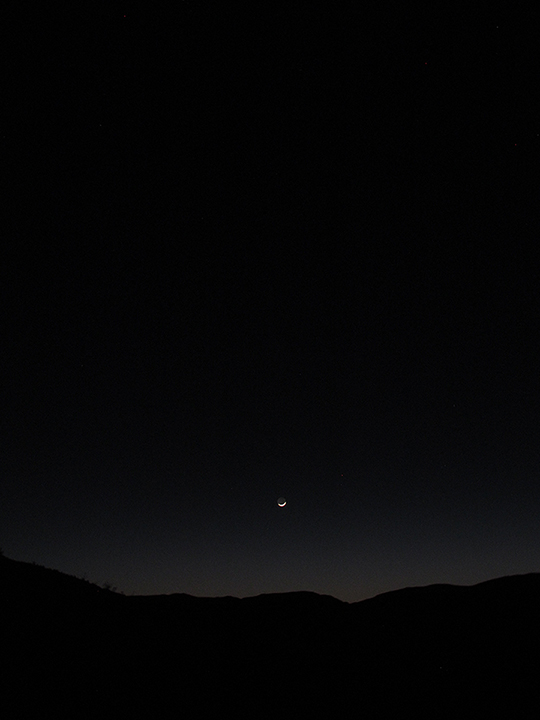Having cleared a circle, I am oriented by the heavens. Artist, analyst, teacher, I live and work nomadically in New York City, Atlanta, and far West Texas in the Lone Star State. I am guided by Buddhism, the work of painter, Agnes Martin and filmmaker, Robert Bresson and psychoanalysis as taught by Jacques Lacan, practices whose effects are felt from the precision of their techniques––silence, line, frame, cut.
Forging a subject extimate to art making was necessary. Years ago in the desert, as an act qua art, I re-inscribed my given name by a letter, a vowel. I was then exiled to a solitude in my studio and elsewhere, singular and unprecedented,
the place of No One Anymore, outside the social bonds of the art world and without the adaptation it enabled.
1 I took refuge in seclusion of the desert. With time to understand and finding life with a woman, I withstood the effects––a migration from the impossible to the possible.
The analytic discourse offered me a tenable means by which to sustain the master discourse of endgame capitalism, perpetuated in the art world via luxury brand-driven art fairs, global exchange markets and international corporate galleries. Adapting to the art discourse as a One-all-alone, I maneuver as such. The coordinates of my outpost are a recovered know-how and a newfound mobility. Renaming precipitated a rewriting. To describe my work, I exchange commonplace art historical terms for singular yet relevant, coeval ones: for instance, mental rather than conceptual and derangement instead of sculpture. Again of the letter but with foreknowledge, I am inclined to refer to my art, in consonance with its Latin origin, as
ars. “Let whoever cannot meet at its horizon the subjectivity of his time give it up then (…) Let him be well acquainted with the whorl into which his era draws him.”
2 Ethically artists too must perpetually re-stake the frontier.
In my
herbarium3, I work sinthomatically, on par with each One according to the singularity of the transference. This one-by-one bespoke orientation, redolent of thus readymade for America, is equipped to contend with the exigencies of life here today. I impart to each speaking/spoken being that our medium is the materiality of speech and its effects on the body. The refinement I seek in my practice is obtained through supervision, cartels and my own analyses, with a man, in Miami, and a woman, in Paris.
In a photography course I teach at an art and design university in New York City, I have a freshman student who was until mid-semester diffident and remote. Two encounters changed this. While informing him he was at risk of failing the course, I was startled by the image on his black hoody, Andres Serrano’s infamous 1987
Piss Christ. When I shared my recognition of the image, the young man lit up. The original Cibachrome print of a plastic crucifix submerged in the artist’s urine was one of a series of photographs the artist made using bodily fluids, including, blood, milk and semen. In the intervening thirty-four years this unholy image excoriated and thus elevated by the U.S. Senate underwent a cultural alchemical transformation––from a subsequent Supreme Court case to
Supreme, the ultimate downtown NYC fashion brand––a mutation that evinces the sovereignty of the image and the increasingly rapacious
push-to-jouir of 21st century America.
There was a second contingent and surprising moment with the same student. Before giving a presentation on artistic innovation that included works of Leigh Bowery, the late Australian performance artist, fashion designer and model for the English painter Lucien Freud, I glimpsed an image of Bowery on the back of the student’s white shirt. At my invitation he stood and showed it to the class, proudly. In 1994, Bowery, a legend in the queer and trans movements, performed at Wigstock, the annual drag music festival held in Tompkins Square Park in New York City. In this infamous performance event, Bowery interrupted his caustic rendition of “Love Stands Tall and Free” to birth from the belly of his oversized costume an abject thing. Naked, covered in theatrical blood, pig intestines and “umbilical cords” of sausages, it was a woman, his future wife, Nicola Bateman. Sharing with the class that I actually saw the performance again impacted my student. He later gave his own presentation on other series by Serrano to illustrate artistic conviction and invention.
And what of artistic fortitude? While struggling to write of my singularity, and as an effect of the inaugural Reading Seminar by Lacanian Compass New York of the lessons from Jacques-Alain Miller's Course "Subtleties in Psychoanalysis", I intuited something about James Joyce, his body and how he wrote. I discovered that while he occasionally resorted to dictation Joyce wrote the majority of his manuscripts by hand. He would write, scrawl, cross out, deface, with pencil, pen, charcoal or crayon, often on oversized pieces of paper or cardboard. One account depicts him lying on his stomach in bed on white linens wearing a white coat writing with pieces of crayon. The reflected light of the fabrics and the larger line of the crayons compensated for his failing vision. Encountering this small yet critical detail of “genetic Joyce criticism” resonated with me. Joyce utilized his body to write. It is in this way that he literally, literarily, embodied his sinthome. Body, mark, line, letter––Joyce the artist.
At the horizon––immanent, evanescent, boundless, arising––my body is an axis between land and sky. I move with the heavens as my constellated artistic practices are iterated, incarnated, from my One place...
1. Jacques Alain-Miller, "Everyone Is Mad",
Culture/Clinic, Eds. Jacques-Alain Miller and Maire Janus (University of Minnesota Press, 2006), 22.
2. Jacques Lacan, "The Function and Field of Speech and Language in Psychoanalysis",
Écrits, trans. Bruce Fink (W.W.Norton & Company 2006), 264.
3. Jacques-Alain Miller, "We Are Haphazardly Driven From Pillar to Post",
Hurly-Burly, Issue 5, March 2011, 28.
Robert Buck © 2022
Download



